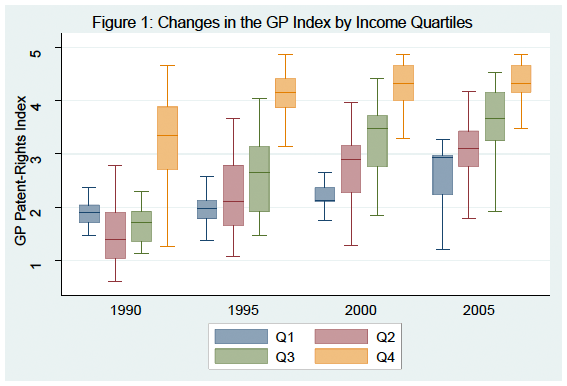| Author Name | Keith E. MASKUS (University of Colorado) / Lei YANG (Hong Kong Polytechnic University) |
|---|---|
| Research Project | Economic Analysis of Technology in the Global Economy |
| Download / Links |
This Non Technical Summary does not constitute part of the above-captioned Discussion Paper but has been prepared for the purpose of providing a bold outline of the paper, based on findings from the analysis for the paper and focusing primarily on their implications for policy. For details of the analysis, read the captioned Discussion Paper. Views expressed in this Non Technical Summary are solely those of the individual author(s), and do not necessarily represent the views of the Research Institute of Economy, Trade and Industry (RIETI).
International Trade and Investment Program (FY2011-FY2015)
Economic Analysis of Technology in the Global Economy Project
Countries vary considerably in their legal protection of intellectual property rights (IPRs) such as patents. In general, higher-income and technologically advanced nations with substantial innovation and creation of new goods prefer much stronger protection than do lower-income economies that are more likely to produce commodity goods. Over the period since 1995, however, after the introduction of the World Trade Organization's (WTO) Agreement on Trade-Related Aspects of Intellectual Property Rights (TRIPS), there has been a major shift in global policy, with developing economies adopting considerably stronger patent rights as a condition of membership in the WTO. Furthermore, some middle-income, rapidly developing economies, such as China, Brazil, and Mexico, have adopted stronger IPRs to protect their emerging innovative industries. These significant policy reforms may be seen in Figure 1, which shows the increase in the famous Ginarte-Park index of patent rights between 1990 and 2005, broken down by income quartiles. It is clear that the index grew far faster for the lower- and middle-income country groups and that substantial upward convergence in the legal protection of patented inventions occurred over this period.
Our interest in this paper is to study whether such reforms in patents have significant effects on the exports of manufactured goods. In theory, as countries strengthen their IPRs, the impact on production is ambiguous. On the one hand, stronger patents make it more difficult for local firms to imitate protected goods and technologies, which could reduce output and exports, particularly in developing economies. On the other hand, patents support contracts in formal technology acquisitions through direct investment and licensing. This tends to raise the access of domestic firms and subsidiaries to the best international technologies and expand their ability to manufacture and export sophisticated goods.
To investigate these hypotheses, we put together a comprehensive database across 82 countries of exports of three-digit manufacturing goods to the United States over the period 1985 to 2005. We specify a comparative advantage-based model of industrial specialization and trade, in which exports depend on the product of factor endowments by country and factor intensities by industry. The novelty is to introduce a measure of enforced patent rights as an endowment of IPRs by country, which changes over time due to both legal reforms and improvements in contracts. We control for the simultaneous causality between IPRs policies and exports.
To summarize our results, we find that stronger patent rights are a significantly positive determinant of exports in patent-intensive goods. For example, a one-standard-deviation improvement in patents in our sample would raise average sectoral exports to the United States by between 13% and 29%, depending on the specification. With respect to changes over time, we split the sample between pre- and post-TRIPS years and find that the responsiveness of exports to patent rights sharply rose in the latter period, suggesting that the WTO reforms generated positive trade impacts. Furthermore, among the developing economies in our sample, we find that the positive effects largely tracked the timing of the introduction of patent reforms. Specifically, the relationship between export growth and patent rights grew uniformly larger in 2000 and 2005, the primary period of TRIPS implementation.
These various results point strongly to the ability of improving patent protection to enhance investments in adopting and developing new technologies, with a positive impact on export growth in both developing and developed countries. What our analysis cannot determine at this point is what the precise channels of learning and adoption over this period might have been--whether increases in direct investment and licensing, improvements in information flows among supply chains, or other elements. This remains a topic for future research.


